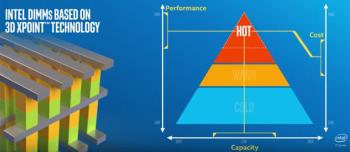Intel announced its first market ready Optane products at CES 2017, in the form of compact slot-format low capacity 'cache SSDs'. These are its first Optane storage solutions. Intel will also be releasing Optane memory DIMMs to fit DDR4 slots in servers, PCs and so on. In an earnings call a few hours ago, in the wake of its latest financials, Intel's CEO said Optane memory DIMMs had started to ship to partners for testing.
While we have seen impressive demonstrations of Optane storage solutions, less is known about the impact that 3D XPoint technology will have when used in place of RAM DIMMs. Intel gave us some insight into its future plans for 3D XPoint memory solutions a couple of years back when we first heard about this new non-volatile memory tech.
As alluded to in the video above, Optane is expected to "completely rewrite the rules of the hot-warm-cold storage pyramid" which determines data server performance, due to its nature of being nearly as fast as DRAM but with similar costs to SSD NAND storage.
With Optane memory DIMMs available it is thought servers will be able to "greatly expand" the high performance hot storage capacity available. Ahead of this Optane tech SSDs are already arriving to perk up the 'warm storage' performance available - without breaking the bank.
It is evident that the above is the reasoning behind Brian Krzanich's statement in the earnings call last night, saying that the "differential technology," provided by Optane products could change PC and server architectures. Data Centre is a very successful segment for Intel and hopefully any architectural revolution in that industry thanks to Optane will trickle down to the PCs of tomorrow. Already, for example, new Lenovo, Dell, Intel and HP PCs and SuperO motherboards have been announced with Optane storage options.







